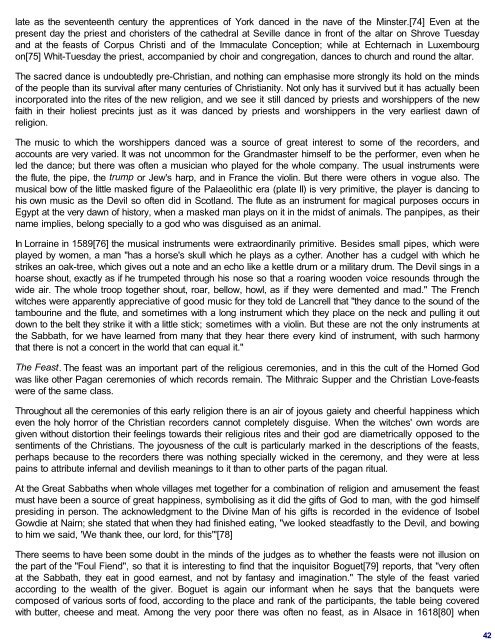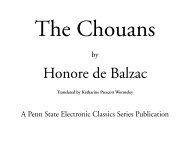THE GOD OF THE WITCHES - World eBook Library - World Public ...
THE GOD OF THE WITCHES - World eBook Library - World Public ...
THE GOD OF THE WITCHES - World eBook Library - World Public ...
You also want an ePaper? Increase the reach of your titles
YUMPU automatically turns print PDFs into web optimized ePapers that Google loves.
late as the seventeenth century the apprentices of York danced in the nave of the Minster.[74] Even at the<br />
present day the priest and choristers of the cathedral at Seville dance in front of the altar on Shrove Tuesday<br />
and at the feasts of Corpus Christi and of the Immaculate Conception; while at Echternach in Luxembourg<br />
on[75] Whit-Tuesday the priest, accompanied by choir and congregation, dances to church and round the altar.<br />
The sacred dance is undoubtedly pre-Christian, and nothing can emphasise more strongly its hold on the minds<br />
of the people than its survival after many centuries of Christianity. Not only has it survived but it has actually been<br />
incorporated into the rites of the new religion, and we see it still danced by priests and worshippers of the new<br />
faith in their holiest precints just as it was danced by priests and worshippers in the very earliest dawn of<br />
religion.<br />
The music to which the worshippers danced was a source of great interest to some of the recorders, and<br />
accounts are very varied. It was not uncommon for the Grandmaster himself to be the performer, even when he<br />
led the dance; but there was often a musician who played for the whole company. The usual instruments were<br />
the flute, the pipe, the trump or Jew's harp, and in France the violin. But there were others in vogue also. The<br />
musical bow of the little masked figure of the Palaeolithic era (plate II) is very primitive, the player is dancing to<br />
his own music as the Devil so often did in Scotland. The flute as an instrument for magical purposes occurs in<br />
Egypt at the very dawn of history, when a masked man plays on it in the midst of animals. The panpipes, as their<br />
name implies, belong specially to a god who was disguised as an animal.<br />
In Lorraine in 1589[76] the musical instruments were extraordinarily primitive. Besides small pipes, which were<br />
played by women, a man "has a horse's skull which he plays as a cyther. Another has a cudgel with which he<br />
strikes an oak-tree, which gives out a note and an echo like a kettle drum or a military drum. The Devil sings in a<br />
hoarse shout, exactly as if he trumpeted through his nose so that a roaring wooden voice resounds through the<br />
wide air. The whole troop together shout, roar, bellow, howl, as if they were demented and mad." The French<br />
witches were apparently appreciative of good music for they told de Lancrell that "they dance to the sound of the<br />
tambourine and the flute, and sometimes with a long instrument which they place on the neck and pulling it out<br />
down to the belt they strike it with a little stick; sometimes with a violin. But these are not the only instruments at<br />
the Sabbath, for we have learned from many that they hear there every kind of instrument, with such harmony<br />
that there is not a concert in the world that can equal it."<br />
The Feast. The feast was an important part of the religious ceremonies, and in this the cult of the Horned God<br />
was like other Pagan ceremonies of which records remain. The Mithraic Supper and the Christian Love-feasts<br />
were of the same class.<br />
Throughout all the ceremonies of this early religion there is an air of joyous gaiety and cheerful happiness which<br />
even the holy horror of the Christian recorders cannot completely disguise. When the witches' own words are<br />
given without distortion their feelings towards their religious rites and their god are diametrically opposed to the<br />
sentiments of the Christians. The joyousness of the cult is particularly marked in the descriptions of the feasts,<br />
perhaps because to the recorders there was nothing specially wicked in the ceremony, and they were at less<br />
pains to attribute infernal and devilish meanings to it than to other parts of the pagan ritual.<br />
At the Great Sabbaths when whole villages met together for a combination of religion and amusement the feast<br />
must have been a source of great happiness, symbolising as it did the gifts of God to man, with the god himself<br />
presiding in person. The acknowledgment to the Divine Man of his gifts is recorded in the evidence of Isobel<br />
Gowdie at Nairn; she stated that when they had finished eating, "we looked steadfastly to the Devil, and bowing<br />
to him we said, 'We thank thee, our lord, for this'"[78]<br />
There seems to have been some doubt in the minds of the judges as to whether the feasts were not illusion on<br />
the part of the "Foul Fiend", so that it is interesting to find that the inquisitor Boguet[79] reports, that "very often<br />
at the Sabbath, they eat in good earnest, and not by fantasy and imagination." The style of the feast varied<br />
according to the wealth of the giver. Boguet is again our informant when he says that the banquets were<br />
composed of various sorts of food, according to the place and rank of the participants, the table being covered<br />
with butter, cheese and meat. Among the very poor there was often no feast, as in Alsace in 1618[80] when<br />
42















